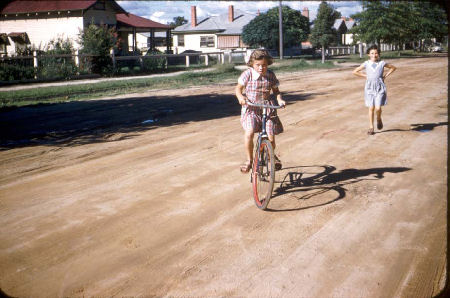The Play and folklore exhibition at the Victorian State Museum is a really interesting one because it testifies to the disappearance of accessible natural places for children, without consciously linking this to overpopulation and development, currently rampant in Victoria.
Ironically it uses photographs by Jim Quirk, the father of SPA Victoria President, population activist, Jill Quirk. The photographs are of his children, whose play he minutely and lovingly documented during the 1950s in Victoria.
These pictures will seem incredibly familiar, perhaps achingly familiar, to many people who grew up during that time in Australia. Jill's father, Jim Quirk, was a bank manager who loved wildlife and, like his daughter, worried greatly about the impact of overpopulation on natural spaces and freedom. He was also an expert colour photographer.
A photograph of Jill and her sister - where, I wonder?
Here is a worthwhile quote from a part of the exhibition:
"Not only do children have less freedom than they once did, but there are also fewer natural spaces available to children to play. Robert Pyle, an American naturalist and writer, explained that a sense of place is gained through intimate contact with natural landscapes, emphasising the importance of the ‘presence of special places and the liberty to encounter them at will’. He argued that as children’s actions are limited by regulations in genuinely wild areas such as national parks, we should be protecting small pockets of unofficial countryside – such as overgrown vacant lots or abandoned buildings – where children can play and explore freely.5"
The exhibition is by museum curator, Carla Pascoe.
 Artist Sheila Newman will be the artist-in-residence at Oak Hill Gallery in Mornington from Wednesday, July 31st to Tuesday, August 6th, 2024. This timely residency comes as the Victorian government prepares to impose significant population growth and high-rise development in the fragile and biodiverse region. Newman's exhibition will feature striking portraits of former M.P.
Artist Sheila Newman will be the artist-in-residence at Oak Hill Gallery in Mornington from Wednesday, July 31st to Tuesday, August 6th, 2024. This timely residency comes as the Victorian government prepares to impose significant population growth and high-rise development in the fragile and biodiverse region. Newman's exhibition will feature striking portraits of former M.P.
 Sustainable Population Australia is pleased to announce the auction of the 4 piece art work “Encroachment” by noted Kimberley artist and SPA member Jackie Ellis.
Sustainable Population Australia is pleased to announce the auction of the 4 piece art work “Encroachment” by noted Kimberley artist and SPA member Jackie Ellis.

Recent comments